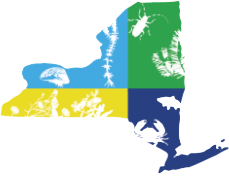Underground Invaders: Impacts and Implications of Non-native Earthworms in North America
Annise Dobson, PhD. Candidate
Department of Natural Resources, Cornell University
Pathway for invasion
For at least the last 11,000 years since the glaciers receded, ecosystems in the Northern United States developed and evolved without earthworms (James 1995). During the late 1800’s and early 1900’s many settlers imported European plants that likely had earthworms or earthworm cocoons (egg cases) in their soils (Bohlen et al. 2004). More recently, the widespread use of earthworms as fishing bait has spread them to more remote areas (Sackett et al. 2012).
Earthworm impacts
Without earthworms, fallen leaves are slowly decomposed by microbes, fungi and soil invertebrates. This creates a spongy layer of organic “duff,” which is the natural substrate for native woodland wildflowers and many tree seedlings. It also provides habitat for ground-dwelling animals and native fungal communities. Invading earthworms consume the leaves that build up to that create the duff layer, often eliminating it completely.
This results in sweeping above and belowground changes, spanning across trophic levels. Sharp declines in soil invertebrate communities are common symptoms in earthworm invaded areas (Zirbes et al. 2012; Trouve et al. 2014).
The loss of soil invertebrates can have widespread consequences, including impacts on species that depend on soil invertebrates for food, such as the ovenbird, hermit thrush and many species of salamanders. Declines in food availability may be compounded for birds by reduced nest success from a decline in shrubs that provide concealment, and for salmanders, the loss of temperature- and moisture-buffered habitat (Maerz et al. 2009).
Big trees with deep roots are generally unaffected by earthworm presence, but evidence is emerging to suggest native understory plant diversity is negatively affected (Hale et al. 2006; Dobson and Blossey 2015). Conversely, some of the most common invasive plant species appear to benefit from worm invasion (Nuzzo et al. 2009).
Many studies have shown earthworms to be a strong selective factor in determining plant community assemblages, with an overall decrease in species richness (McGraw and Furedi 2005; Frelich et al. 2006; Holdsworth et al. 2007; Dobson and Blossey 2015).
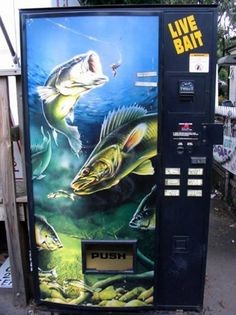
Figure 1. European earthworms are readily available as fishing bait.
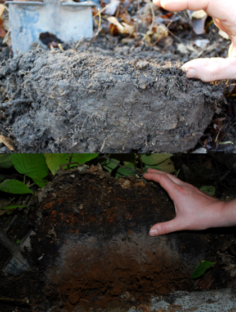
Figure 2. Above: Earthworm-invaded soil profile lacking stratification. Below: Intact duff layer over stratified soil profile without earthworms.
Active areas of research
Understanding the sum total of earthworm influence is complicated, because direct, indirect, biological, physical and chemical changes are occurring simultaneously. In my research, I seek to understand changing impacts of earthworms throughout the life cycle of 21 native plant species, including ferns, grasses, sedges, trees, shrubs and herbs. All species are planted into 20 plots with variable earthworm abundances. Initially, seedling survival was almost universally lower in earthworm-invaded plots, with the exception of two fern species.
We hypothesize that by removing the forest floor and its temperature and moisture buffering capacity, earthworms contribute to young seedling desiccation and death (Larson et al. 2009). Species in the order Liliales (Trillium, True and False Solomon’s Seal) are particularly hard-hit, continually declining each year in earthworm invaded plots.
However, active restoration may provide a solution to forests where earthworms have depleted understory communities. Transplanted seedlings of many species that survived the harsh conditions in initial growing seasons in earthworm invaded plots are very likely to survive, flourish and reproduce in bare, post-invasion soils.
We are currently seeking to elucidate the mechanisms underlying earthworm influence on plant success. Earthworm activity has enormous influences on macro- and micro-nutrient cycling. Rapid decomposition of organic matter may increase bioavailability of nutrients, but they may be rapidly lost from the system through leaching (Scheu 1994; Bohlen 2004). Therefore, we expect earthworms to widen the breath of ecological ‘winners’ (rapidly-growing species that can take advantage of nutrient pulses), and ‘losers’ (slow-growing perennials than cannot). This may be exacerbated by the close dependence of the latter on mycorrhizal symbionts to provide previously unavailable nutrients (Lawrence 2003).
Control recommendations
Currently, we have no viable earthworm control methods to recommend. Pesticides, predators and parasites known to affect earthworms would all have large consequences for other forest species and cycles. Public awareness is key to this effort and fishermen and vermicomposters should be strongly discouraged from releasing earthworms or their egg cocoons into the wild. Egg cocoons can be transported in the wheels of ATVs, logging equipment, and may even hitch a ride on the treads of your hiking boots (Sackett et al. 2012; Drouin et al. 2016).
Attention should be given to ensure potentially contaminated soil is not being transported between regions. Without humans to do the leg work, earthworms don’t move very quickly at all, rarely exceeding 10m per year in the absence of human-mediated transport (Tiunov et al. 2006; Hendrix et al. 2008). This is further support for public education and outreach and increased use of boot brush stations when exiting earthworm invaded forests.
The Great Lakes Worm Watch Program (see also Callaham et al. 2006) is an educational resource that has seen some success in preventing spread of earthworms, particularly very problematic new invader, Amynthas. In addition to very readable background information, it provides standardized protocols for citizen scientists and educators to determine the extent of earthworm invasion, the species present, and a means to analyse the data. It also provides games and lesson plans for increased awareness among students.
Identifying Invaded Sites
There are several earthworm sampling methods, but mustard extraction is one of the easiest, safest and most accurate (Lawrence & Bowers 2002).
Once you have an area you would like to sample, you will need ground mustard seed, gallon jugs fillled with water, a vial for containing earthworms, and a square quadrat (pictured, right, 50cm x 50cm works well).
To extract earthworms, first mix 1/3 cup of ground mustard seed per gallon of water, mix well and let sit for at least 15 minutes. Next, take your quadrat and lay it on the ground in your chosen location. Remove the top layer of leaf litter within this area and manually search for and collect any small epigeic earthworms hidden on the underside of leaves. Pour half of the gallon slowly over the ground underneath the quadrat.
The mustard liquid irritates the earthworms’ skin and will cause them to come up to the surface. Here, you can rinse them with water, place them in a dish and identify them in the field. If they cannot be identified in the field, you can kill them in 70% ethanol, fix them in 10% formalin, preserve them in 70% ethanol, and identify them using a dissecting scope and a dichotomous key. I would recommend Cindy Hale’s Earthworms of the Great Lakes, available from the Great Lakes Worm Watch website.
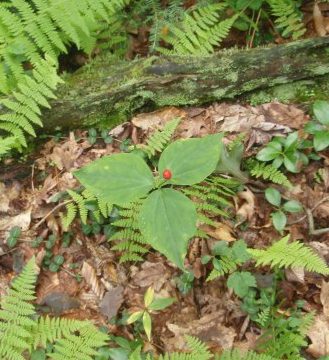
Figure 3. Trillium (a member of the Liliales) in fruit

Figure 4. Sampling earthworms using the liquid mustard method.
Earthworm identification
Earthworms differ in behavior, food, habitat preference and impact on ecosystems. Endogeic earthworms feed in the soil and live in horizontal burrows. These earthworms will interact with deeper-rooted plant species, and have a large impact on soil stratification and nutrient leaching. Because they live in deeper soil layers, they are rarely pigmented.
Anecic earthworms feed on both soil and leaf litter. They can have deep vertical burrows, allowing them to access leaves on the soil surface and retreat to lower levels. Anecic worms, such as the Canadian nightcrawler, Lumbricus terrestris, grows very large and can consume an entire seasons’ worth of leaf litter, leaving bare ground with deteriorated soil structure (Burtelow et al. 1998; Bohlen et al. 2004; Frelich et al. 2006). These worms can be deeply pigmented, particularly on their dorsal side.
Epigeic earthworms live in leaf litter, feeding on organic matter, microbes, fungi and even live plant roots. While a small density of epigeic earthworms may not have enormous impacts on forest cycling, once established, they may disproportionally affect shallow-rooted perennial plants, soil invertebrates and ground-dwelling vertebrates. Because they dwell near the soil surface and are exposed to UV radiation from the sun, epigeic earthworms are often highly pigmented.
Some epigeic earthworms, such as the Alabama jumper, Amynthas agrestis, are voracious eaters, fast growers, and can reach incredible densities. Then consume vast amounts of organic matter, and create gravel-like castings in which even the most robust of plants cannot survive. Due to the wide range of possible impacts from different species, understanding the earthworm community composition can help target management solutions.
Literature Cited
Bohlen PJ, Scheu S, Hale CM, McLean MA, Migge S, Groffman PM, Parkinson D. 2004. Non-native invasive earthworms as agents of change in northern temperate forests. Front. Ecol. Environ. 2:427–435.
Burtelow AE, Bohlen PJ, Groffman PM. 1998. Influence of exotic earthworm invasion on soil organic matter, microbial biomass and denitrification potential in forest soils of the northeastern United States. Appl. Soil Ecol. 9:197–202.
Dobson A, Blossey B. Earthworm invasion, white-tailed deer and seedling establishment in deciduous forests of north-eastern North America.
Drouin M, Bradley R, Lapointe L. 2016. Forest ecology and management linkage between exotic earthworms, understory vegetation and soil properties in sugar maple forests. For. Ecol. Manage. 364:113–121.
Frelich LE, Hale CM, Scheu S, Holdsworth AR, Heneghan L, Bohlen PJ, Reich PB. 2006. Earthworm invasion into previously earthworm-free temperate and boreal forests. Biol. Invasions 8:1235–1245.
Hale CM, Frelich LE, Reich PB. 2006. Changes in cold-temperate hardwood forest understory plant communities in response to invasion by European earthworms. Ecology 87:1637–1649.
Hendrix PF, Callaham M a., Drake JM, Huang C-Y, James SW, Snyder B a., Zhang W. 2008. Pandora’s Box contained bait: The global problem of introduced earthworms *. Annu. Rev. Ecol. Evol. Syst. 39:593–613.
Holdsworth AR, Frelich LE, Reich PB. 2007. Regional extent of an ecosystem engineer: Earthworm invasion in northern hardwood forests. Ecol. Appl. 17:1666–1677.
James SW. 1995. Systematics, biogeography, and ecology of nearctic earthworms from eastern, central, southern and southwestern United States. In: Hendrix PF, editor. Earthworm ecology and biogeography in North America. Lewis. p. 29–52.
Larson ER, Kipfmueller KF, Hale CM, Frelich LE, Reich PB. 2010. Tree rings detect earthworm invasions and their effects in northern Hardwood forests. Biol. Invasions 12:1053–1066.
Lawrence AP, Bowers MA. 2002. A test of the “hot” mustard extraction method of sampling earthworms. Soil Biol. Biochem. 34:549–552.
Lawrence B, Fisk MC, Fahey TJ, Suarez ER. 2003. Influence of nonnative earthworms on mycorrhizal colonization of sugar maple (Acer saccharum). New Phytol. 157:145–153.
Maerz JC, Nuzzo VA, Blossey B. 2009. Declines in woodland salamander abundance associated with non-native earthworm and plant invasions. Conserv. Biol. 23:975–981.
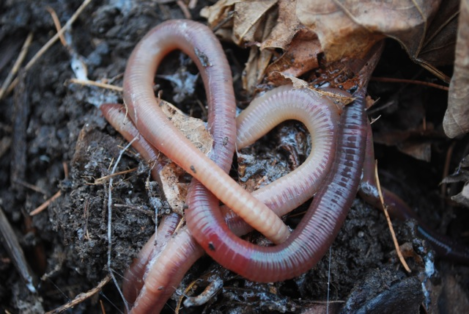
Figure 5. Lumbricus terrestris, in a midden above its deep vertical burrow.

